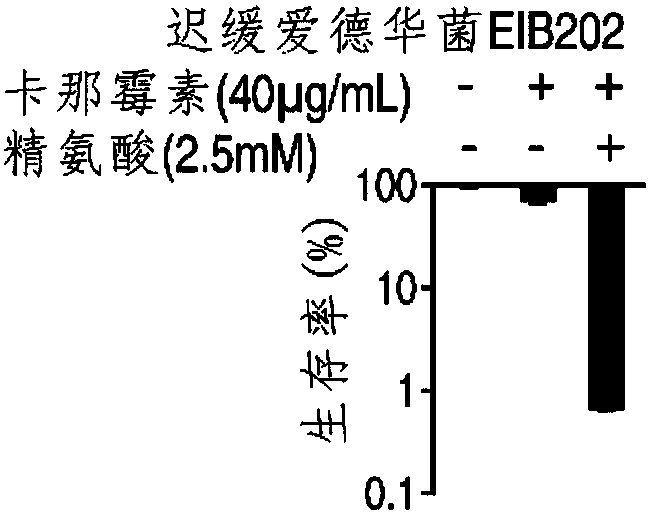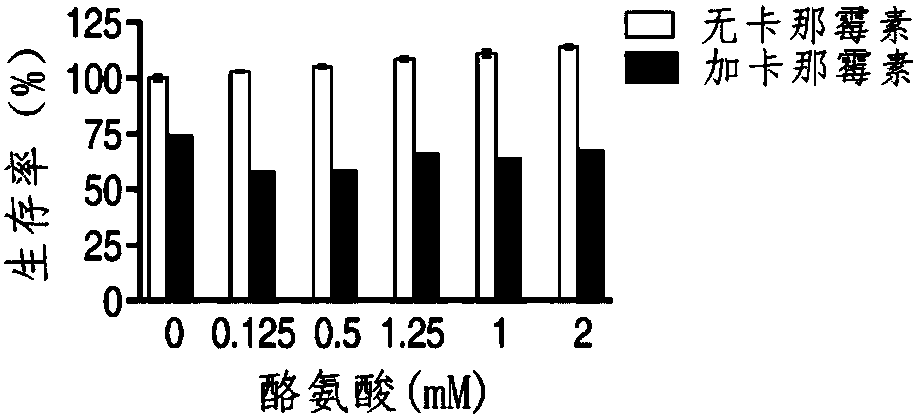Application of L-arginine in improvement of antibiotics sensitivity of bacteria
A technology of antibiotics and arginine, applied in the field of medicine, achieves good application prospects, overcomes bacterial resistance, high safety and operability
- Summary
- Abstract
- Description
- Claims
- Application Information
AI Technical Summary
Problems solved by technology
Method used
Image
Examples
Embodiment 1
[0037] Example 1 L-arginine improves the sensitivity of Edwardsiella tarda to kanamycin
[0038] 1. Determination of drug resistance of Edwardsiella tarda EIB202
[0039] Edwardsiella tarda is a Gram-negative short bacillus, which was first reported by Hoshina in 1962 and is related to reddisease of Japanese eels. From the first report to the present, the fungus has caused diseases in more than 20 kinds of fish, such as eel, flounder, tilapia, Chinese soft-shelled turtle, carp, etc., causing huge losses to aquaculture. Edwardsiella tarda is also a common pathogenic bacteria in humans and fish, which directly poses a threat to human health.
[0040] Firstly, the minimum inhibitory concentration of Edwardsiella tarda to various antibiotics was determined. The results showed that the minimum inhibitory concentration of Edwardsiella tarda EIB202 to kanamycin was 12.5 μg / mL, the minimum inhibitory concentration to tetracycline was 125 μg / mL, and the minimum inhibitory concentrati...
Embodiment 2
[0055] Example 2 L-arginine improves the sensitivity of Edwardsiella tarda to other antibiotics
[0056] In order to know whether the addition of L-arginine can improve the sensitivity of Edwardsiella lentus to antibiotics other than kanamycin, the bacterial samples were prepared according to the method in step 2 of Example 1. The experiment was divided into 3 groups: 2 control groups (control group 1: no addition of antibiotics and L-arginine; control group 2: addition of antibiotics only) and 1 experimental group (addition of an antibiotic and L-arginine) . The added antibiotics and their concentration were: 12.5 μg / mL ampicillin, 2 μg / mL baroxacin and 50 μg / mL cefazolin sodium. After 6 hours of action, the number of viable bacteria was counted to calculate the survival rate.
[0057] The result is as Figure 5 As shown, after adding L-arginine, the sensitivity of Edwardsiella tarda to ampicillin was increased by 5.13 times (survival rate dropped from 60.03% of only addin...
Embodiment 3
[0059] Example 3 L-arginine improves the sensitivity of various bacteria to kanamycin
[0060] 1. Preparation of bacteria solution
[0061] Pick Escherichia coli K12, Pseudomonas aeruginosa, Streptococcus B, and Staphylococcus aureus (MASA) and other bacterial monoclonals into 100mL LB liquid medium, at 37°C or 30°C, 200rpm Under culture for 16h to reach saturation. Collect 20 mL of each bacterial liquid, centrifuge at 8000 rpm for 5 min, remove the supernatant and wash the cells with an equal volume of 0.85% normal saline, and finally suspend the cells with 1× M9 basic liquid medium (containing 10 mM acetate) , adjust the OD value of the bacterial solution to 0.5, and then aliquot 5 mL into test tubes for later use.
[0062] 2. L-arginine increases the sensitivity of various bacteria to kanamycin
[0063] The above-mentioned prepared bacterial solution was divided into 3 groups according to the type of bacteria: 2 control groups (control group 1: no addition of kanamycin a...
PUM
 Login to View More
Login to View More Abstract
Description
Claims
Application Information
 Login to View More
Login to View More - R&D
- Intellectual Property
- Life Sciences
- Materials
- Tech Scout
- Unparalleled Data Quality
- Higher Quality Content
- 60% Fewer Hallucinations
Browse by: Latest US Patents, China's latest patents, Technical Efficacy Thesaurus, Application Domain, Technology Topic, Popular Technical Reports.
© 2025 PatSnap. All rights reserved.Legal|Privacy policy|Modern Slavery Act Transparency Statement|Sitemap|About US| Contact US: help@patsnap.com



